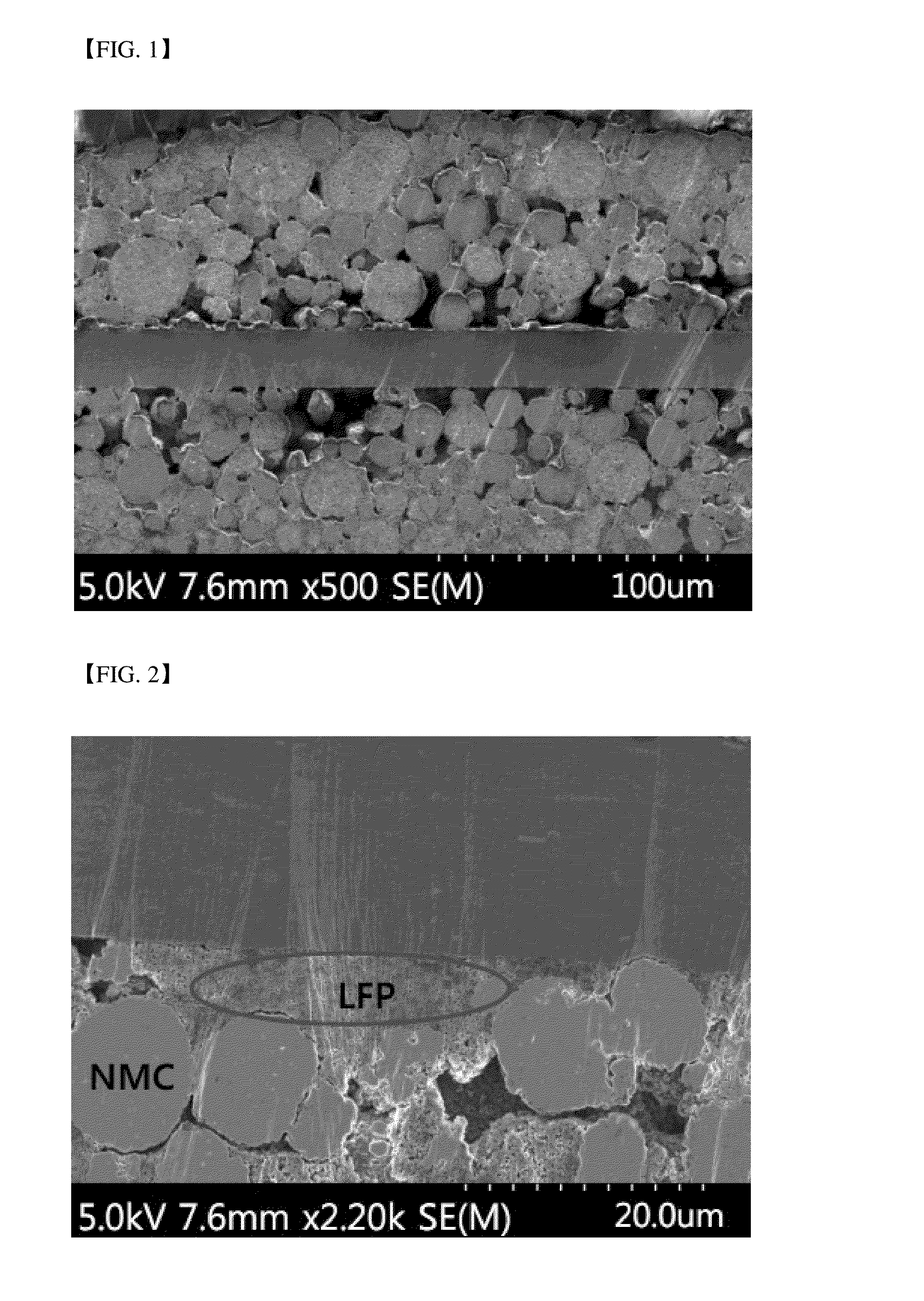Positive electrode for secondary batteries and secondary battery including the same
a secondary battery and positive electrode technology, applied in the field of secondary batteries and positive electrodes for secondary batteries, can solve the problems of low safety, limited use of lithium ions as power sources in electric vehicles and the like, and high cost of licoo/sub>2, so as to achieve the effect of enhancing battery capacity characteristics and output characteristics, reducing the risk of licoo damage, and increasing the diffusivility of lithium ions
- Summary
- Abstract
- Description
- Claims
- Application Information
AI Technical Summary
Benefits of technology
Problems solved by technology
Method used
Image
Examples
example 1
[0073]Using LiFePO4 (product name: EXM2274) manufactured by Clariant, secondary particles having an average particle diameter of 10 micrometers were prepared in a ratio of 95% based on the total volume of LiFePO4. In addition, LiNi1 / 3Mn1 / 3Co1 / 3O2. secondary particles having an average particle diameter of 30 micrometers were prepared in ratio of 95% based on the total volume of LiNi1 / 3Mn1 / 3CO1 / 3O2. Subsequently, the LiFePO4 manufactured by Clariant (product name: EXM2274) and LiNi1 / 3Mn1 / 3Co1 / 3O2 were mixed in a ratio of 3:7 based on the total weight of positive electrode active material.
[0074]92% by weight of the positive electrode active material, 3% by weight of Super-P as a conductive material and 5% by weight of PVdF as a binder were added to NMP to prepare a slurry for a positive electrode mix. Subsequently, the slurry was coated, dried and rolled on a side of aluminum foil, thereby manufacturing a positive electrode.
experimental example 1
[0076]Secondary particle volume ratios in LiFePO4 and LiNi1 / 3Mn1 / 3Co1 / 3O2 after rolling according to Example 1 and Comparative Example 1 were measured.
[0077]In Example 1, a ratio of LiNi1 / 3Mn1 / 3Co1 / 3O2 secondary particles was 85% based on the total volume of LiNi1 / 3Mn1 / 3Co1 / 3O2, and a ratio of LiFePO4 primary particles was 90% based on the total volume of LiFePO4.
[0078]In Comparative Example 1, a ratio of LiNi1 / 3Mn1 / 3Co1 / 3O2 secondary particles was 90% based on the total volume of LiNi1 / 3Mn1 / 3C1 / 3O2 and a ratio of LiFePO4 primary particles was 45% based on the total volume of LiFePO4.
experimental example 2
[0079]FIG. 1 illustrates a cross-sectional SEM image of the positive electrode before rolling, and FIG. 2 illustrates a cross-sectional SEM image of the positive electrode after rolling, according to Example 1. FIG. 3 illustrates a cross-sectional SEM image of the positive electrode after rolling according to Comparative Example 1.
[0080]Referring to FIG. 2 below, it can be confirmed that, in the positive electrode for secondary batteries according to the present invention, the lithium iron phosphate having an olivine crystal structure is collapsed to primary particles upon rolling and most of the lithium nickel-manganese-cobalt composite oxide particles maintain a shape thereof.
[0081]Although the preferred embodiments of the present invention have been disclosed for illustrative purposes, those skilled in the art will appreciate that various modifications, additions and substitutions are possible, without departing from the scope and spirit of the invention as disclosed in the accom...
PUM
| Property | Measurement | Unit |
|---|---|---|
| particle diameter | aaaaa | aaaaa |
| particle diameter | aaaaa | aaaaa |
| thickness | aaaaa | aaaaa |
Abstract
Description
Claims
Application Information
 Login to View More
Login to View More - R&D
- Intellectual Property
- Life Sciences
- Materials
- Tech Scout
- Unparalleled Data Quality
- Higher Quality Content
- 60% Fewer Hallucinations
Browse by: Latest US Patents, China's latest patents, Technical Efficacy Thesaurus, Application Domain, Technology Topic, Popular Technical Reports.
© 2025 PatSnap. All rights reserved.Legal|Privacy policy|Modern Slavery Act Transparency Statement|Sitemap|About US| Contact US: help@patsnap.com



